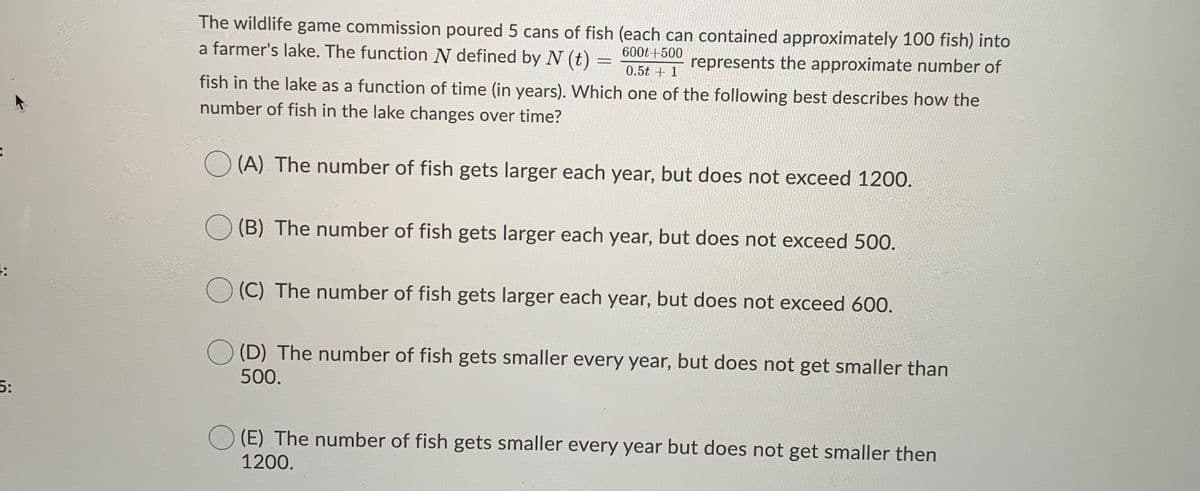The wildlife game commission poured 5 cans of fish (each can contained approximately 100 fish) into a farmer's lake. The function N defined by N (t) = 600t +500 represents the approximate number of 0.5t + 1 fish in the lake as a function of time (in years). Which one of the following best describes how the number of fish in the lake changes over time? O (A) The number of fish gets larger each year, but does not exceed 1200. (B) The number of fish gets larger each year, but does not exceed 500. (C) The number of fish gets larger each year, but does not exceed 600. (D) The number of fish gets smaller every year, but does not get smaller than 500. (E) The number of fish gets smaller every year but does not get smaller then 1200.
The wildlife game commission poured 5 cans of fish (each can contained approximately 100 fish) into a farmer's lake. The function N defined by N (t) = 600t +500 represents the approximate number of 0.5t + 1 fish in the lake as a function of time (in years). Which one of the following best describes how the number of fish in the lake changes over time? O (A) The number of fish gets larger each year, but does not exceed 1200. (B) The number of fish gets larger each year, but does not exceed 500. (C) The number of fish gets larger each year, but does not exceed 600. (D) The number of fish gets smaller every year, but does not get smaller than 500. (E) The number of fish gets smaller every year but does not get smaller then 1200.
Glencoe Algebra 1, Student Edition, 9780079039897, 0079039898, 2018
18th Edition
ISBN:9780079039897
Author:Carter
Publisher:Carter
Chapter8: Polynomials
Section8.1: Adding And Subtracting Polynomials
Problem 44PPS
Related questions
Question

Transcribed Image Text:The wildlife game commission poured 5 cans of fish (each can contained approximately 100 fish) into
a farmer's lake. The function N defined by N (t)
600t +500
represents the approximate number of
0.5t + 1
fish in the lake as a function of time (in years). Which one of the following best describes how the
number of fish in the lake changes over time?
O (A) The number of fish gets larger each year, but does not exceed 1200.
(B) The number of fish gets larger each year, but does not exceed 500.
(C) The number of fish gets larger each year, but does not exceed 600.
(D) The number of fish gets smaller every year, but does not get smaller than
500.
5:
(E) The number of fish gets smaller every year but does not get smaller then
1200.
Expert Solution
This question has been solved!
Explore an expertly crafted, step-by-step solution for a thorough understanding of key concepts.
This is a popular solution!
Trending now
This is a popular solution!
Step by step
Solved in 2 steps

Knowledge Booster
Learn more about
Need a deep-dive on the concept behind this application? Look no further. Learn more about this topic, calculus and related others by exploring similar questions and additional content below.Recommended textbooks for you

Glencoe Algebra 1, Student Edition, 9780079039897…
Algebra
ISBN:
9780079039897
Author:
Carter
Publisher:
McGraw Hill

Trigonometry (MindTap Course List)
Trigonometry
ISBN:
9781337278461
Author:
Ron Larson
Publisher:
Cengage Learning


Glencoe Algebra 1, Student Edition, 9780079039897…
Algebra
ISBN:
9780079039897
Author:
Carter
Publisher:
McGraw Hill

Trigonometry (MindTap Course List)
Trigonometry
ISBN:
9781337278461
Author:
Ron Larson
Publisher:
Cengage Learning


Intermediate Algebra
Algebra
ISBN:
9781285195728
Author:
Jerome E. Kaufmann, Karen L. Schwitters
Publisher:
Cengage Learning

Algebra for College Students
Algebra
ISBN:
9781285195780
Author:
Jerome E. Kaufmann, Karen L. Schwitters
Publisher:
Cengage Learning

Holt Mcdougal Larson Pre-algebra: Student Edition…
Algebra
ISBN:
9780547587776
Author:
HOLT MCDOUGAL
Publisher:
HOLT MCDOUGAL